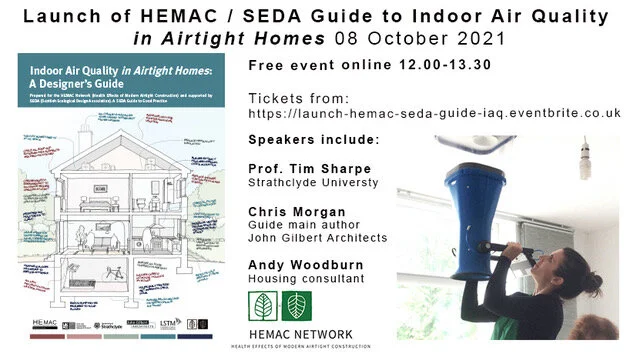SEDA announce the launch of the new essential guide to best practice, produced for the HEMAC Network by Chris Morgan and John Gilbert Architects, and at this free online event will outline its key lessons in maintaining healthy internal environments in modern low energy homes.
Making buildings airtight is good for comfort and energy efficiency, but it comes with risks to our health if not properly managed. Airtight homes can overheat, become too humid and suffer from mould and a number of indoor air pollutants which harm human health, especially in those more vulnerable such as children, the elderly and those with respiratory or immunity problems.
Avoiding these problems is relatively simple however, and this new guide from HEMAC and SEDA describes how to minimise the creation of indoor air pollutants, and effectively ventilate them away, to create fresh and healthy buildings which are also warm and comfortable!
In this event, we are launching the new guide which should be of interest to anyone interested in improving health within the home, but is particularly aimed at Architects and other designers, as well as homeowners and those responsible for providing and maintaining homes for others, such as private landlords, factors, council housing officers and those who work in social housing provision and broader healthcare.
Prof. Tim Sharpe, Head of the Architecture Department at Strathclyde Uni was one of the Lead Investigators in the HEMAC Network and commissioned the guide. He will discuss the wider context of HEMAC and the various initiatives across the Uk to improve ventilation and indoor health. Catherine Cosgrove, Chair of SEDA will introduce SEDA and provide an update on recent and upcoming events as well as other resources of interest.
Chris Morgan, main author of the guide will present the sections of the guide, and Andy Woodburn, an independent development officer for Govanhill and Cathcart & District Housing Associations will offer a client’s perspective on the need to improve housing for tenants.
Join us for this online event, which will be held on Zoom. You will receive a link to join us on the say when you reserve your your place. There will be time for questions and answers as well as some discussion.
Reserve your places from:
https://launch-hemac-seda-guide-iaq.eventbrite.co.uk
Fine out more about SEDA and the HEMAC Network at:
And buy / download the previous SEDA Guides at:
https://www.seda.uk.net/design-guides
Key speaker details:
Chris Morgan is the main author of the new report, and previously lead on other SEDA Guides, including the most recent Guide to Sustainable Renovation. He is an architect and a Director at John Gilbert Architects with over 30 years’ experience in ecological design and sustainable development. He has maintained a range of experience from masterplanning and energy infrastructure, through to award-winning and innovative architecture, research and teaching. Previously a Chair of the Scottish Ecological Design, Chris is one of only three architects with advanced sustainable architecture accreditation from the RIAS. He is a design review panellist for Architecture + Design Scotland and has certification in Passivhaus design, building biology (buildings and health) and permaculture.
Prof. Tim Sharpe is Sharpe has both practice and research expertise in low energy and sustainable architecture, construction, particularly ventilation, health and indoor air quality in housing. He was previously Director of the Mackintosh Environmental Architecture Research Unit and is now Head of the Department of Architecture at the University of Strathclyde. He has been PI and CI on a range of projects investigating low energy and sustainable design with a value of over £6.5m and recent projects include Influence of ventilation design on the prevalence of anti-microbial bacteria in homes,. He was a member of the NICE Public Health Advisory Committee on Indoor Air Quality, RCPCH working Group on IAQ and children’s health. He is a member of the Scientific Advisory Group for Emergencies Environment and Modelling Group and has extensive experience of monitoring indoor environments. He has led on a several projects for Scottish Government Building Standards Division. He is a CI on the SFC funded Niddrie Rd. Passivhaus Tenement retrofit COP26 demonstration project.
Andy Woodburn is an independent development consultant working most recently with Govanhill and Cathcart & District Housing Associations. He has worked extensively to develop both new build and refurbished housing and community projects over the last twenty years. Andy will offer a client perspective on the drivers in social housing development and the need to provide healthy homes for tenants.

